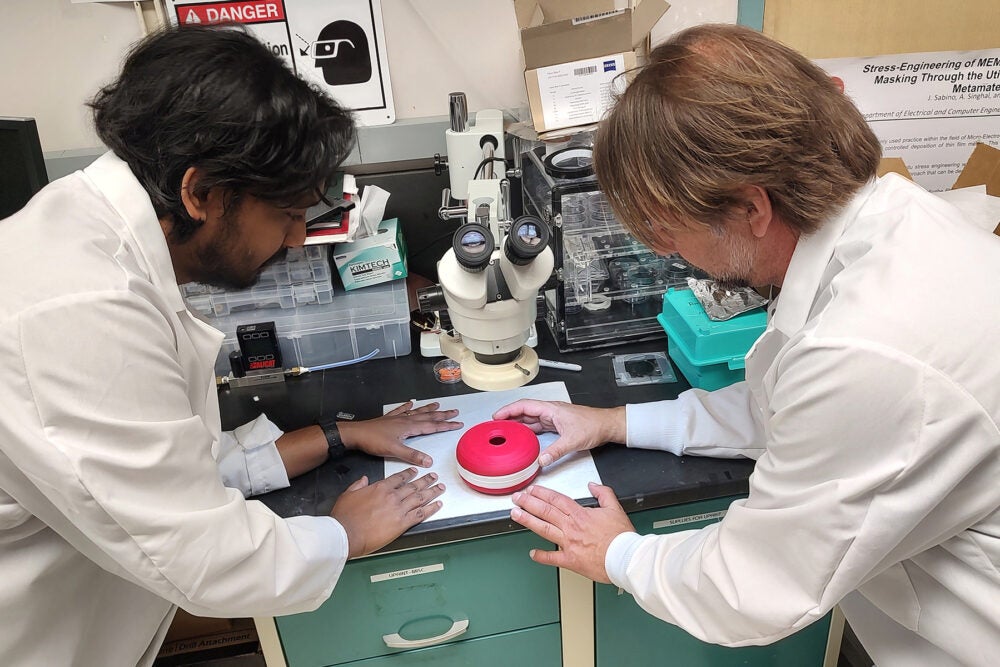A smoke detector for viruses?
A smoke detector for viruses?

The COVID-19 pandemic spiked anxiety about an invisible threat: airborne viral particles. The inability to detect the presence of these microscopic pathogens necessitated the disruptive precautionary measures of the COVID-19 era, such as masks, social distancing and the shutdown of schools, workplaces and large public gatherings.
But what if airborne viruses could be detected in the same manner as smoke, carbon monoxide and other environmental dangers? Two University of Illinois Chicago scientists have collaborated on a device that could detect SARS-CoV-2, influenza, RSV and other pathogens. The technology, called BioAerium, could dramatically improve disease surveillance for public health as well as research on how viral particles move through the air.
The device earned its creators Michael Caffrey, professor of biochemistry and molecular genetics, and Igor Paprotny, associate professor of electrical and computer engineering, the 2022 Inventor of the Year award from UIC. Their work is also the basis of a new startup company, also called BioAerium, which is exploring commercial opportunities of the technology.
While COVID-19 accelerated the urgency of Caffrey and Paprotny’s project, their collaboration actually formed before the pandemic, with the flu virus as their initial target. Caffrey’s research studies the structure of viruses such as influenza, HIV and Ebola using laboratory methods to reveal the intricate architecture of these pathogens and how it relates to their activity. Paprotny’s expertise is in the study and design of microfluidic systems, which work with tiny amounts of fluid, usually liquid; however, most of his devices work to detect aerosols – minute particles in the air.
Because a respiratory virus detector needs to detect small quantities of viral bioaerosols — aerosol that contain viruses — the combination of their specialties provided the ideal partnership for the challenge.
“The viruses that I study are, for the most part, airborne,” Caffrey said. “Viruses in air form larger particles, and those particles are analogous to many of the particle types that Igor’s lab was studying before. So, it was a natural fit.”
Devices for detecting airborne viruses already exist, but they are bulky and expensive, making them impractical for widespread use. The technique for identifying a target virus, DNA amplification, is traditionally performed in a laboratory, so that step needs to be both automated and miniaturized in order to create a portable or wearable detector.
Recent “lab-on-a-chip” technologies – similar to what makes a home COVID-19 test work – address this challenge, but typically require high-concentration samples from saliva or a nose swab. So Caffrey and Paprotny needed to tackle two challenges: shrinking down the biochemical analysis and collecting enough viral particles from the air for it to work.
Enter the UIC nanotechnology core facility, where Paprotny is the faculty research director. With microfabrication – the manufacturing of complex technologies at an exceedingly small size – the researchers could design detectors that are both practical for non-laboratory use and inexpensive enough to make at scale
“We’re in this nice sweet spot where we had a lot of technology that was already developed on the air microfluidic side, and we connected with Mike who was an expert on the virology side,” Paprotny said. “By connecting the two together, we could come up with this device that’s really novel and has a lot of promise going forward.”
Currently, the BioAerium prototype detects one virus at a time; for example, a detector could be set up to look for SARS-CoV-2 and placed in a classroom or airplane to monitor the air for the virus that causes COVID-19. But Caffrey and Paprotny designed the device as an open, customizable platform and envision a future “multiplex” version that can detect many viruses at once, or even distinguish between variants of a virus.
“COVID is maybe going away, but we’re looking at this project as preparing for the next pandemic, and for diseases like the flu where it will be beneficial to be able to detect the presence of a virus,” Paprotny said. “We may even be able to tell whether we are detecting a flu variant that people are vaccinated against or a different strain. Making those distinctions can be especially important.”
The small size and low cost of the device could also enable exciting new science. With multiple detectors installed in a building, across a campus, or throughout a neighborhood, researchers could study in unprecedented detail how a virus spreads through the air and detect emerging variants in real-time, instead of waiting for infections and patient tests.
“We envision that such devices would be connected to the Internet of Things,” Caffrey said. “One could then take advantage of big data science to analyze the signals coming out in multiple areas and provide a global picture that would be useful from a public health perspective.”
Caffrey and Paprotny are currently working with the Office of Technology Management on commercializing their detector technology and have filed for patents. For more information, visit the BioAerium website. Read more about the Research, Scholar, and Inventor of the Year award recipients at the Office of the Vice Chancellor of Research website.